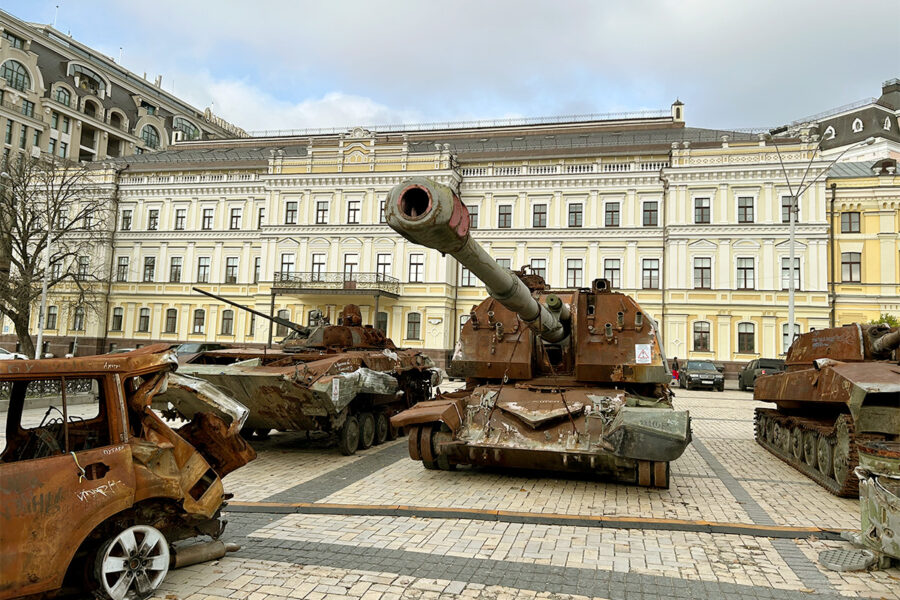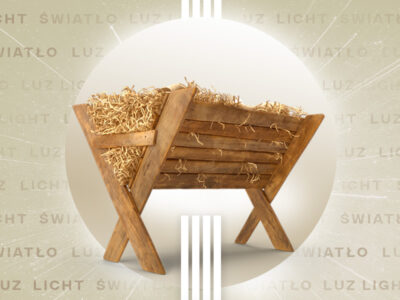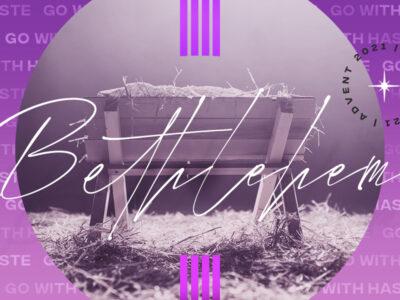Faith and tears in Kyiv
‘Highest risk!’, ‘Code red!’, ‘Do not travel!’ International governmental advice is clear about the conditions for travelling to Ukraine, a country at war. There are no flights. The most convenient way to get to Kyiv is to take the night train from Warsaw, which takes about 20 hours to reach its destination. The long train journey offers the possibility for extensive and fascinating dialogue with my military travel companions. The well-used Ukrainian train carriages are nostalgic with their outdated interior and rather bare for current standards. At the border, our train stands still for several hours. Passports are checked and stamped by grim looking border guards, first on the Polish side, then on the Ukrainian side. We are in Ukraine!
2014-2022
But what am I doing on a train to Kyiv at this moment? I am travelling with two retired high-ranking military officials from the Apostolat Militaire International (AMI). Our organisations have worked together in the development of the military app Catholic Military Connect. This was translated into Ukrainian, as was the booklet Tweeting with GOD Military with special questions for Christian military personnel. We want to show our closeness to the suffering of local partners and see how we can help them support people in their faith in this difficult time.
Since the annexation of Crimea in 2014, tensions in the country have been high. I remember the heated questions about the armed conflict in the border provinces by seminarians during my 2017 visit to Ukraine (see God is still at work, page 113). With the Russian invasion in February 2022, this became a full-scale war. As our train arrives punctually in Kyiv, I remember the images of long lines of military vehicles on roads towards the capital they never reached.

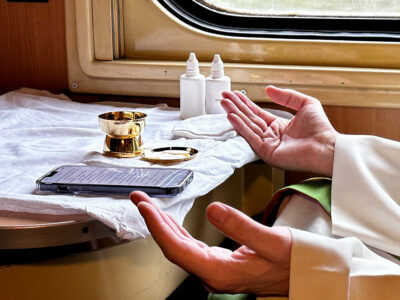

Government & Bishops
We meet with Ukrainian government officials. Among other things, we learn how they want to use technology to reach veterans and express great interest when they hear about our military app. At the Dutch Embassy, we are informed about the various aspects of the local context and the situation in Kyiv at this moment.
Two Roman Catholic bishops have invited us for lunch and we have a very animated dialogue. They express great enthusiasm for the DeoQuest initiatives they already know and are very happy to hear about the availability of the Catholic Military Connect app in Ukrainian. We also have tea with a representative of the Greek Catholic Church. He would love to have more copies of our booklet with military questions for use on the front line. Chaplains are few, and the use of our app is limited to times when phones can be used safely. The search is for resources to help soldiers who try to pray and live as Christians also when active in the armed forces.
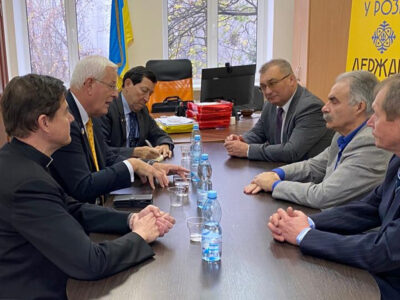
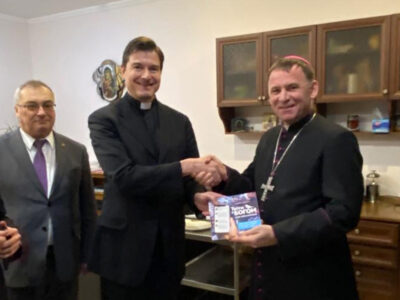
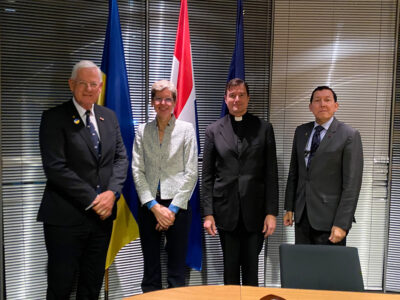
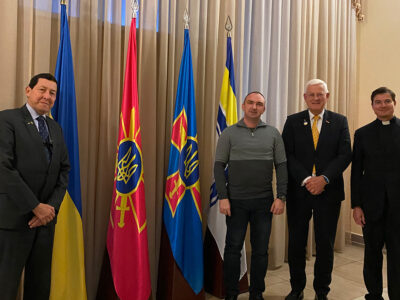
Beauty & sadness
To our surprise, the two-day visit does not only allow for many meetings with relevant people, but our hosts insist on showing us something of the beauty of their city. We visit the Lavra monastery, where religious life started in caves, and which now consists of hundreds of cells and churches. It is one of the greatest monuments for Orthodox Christianity. Sadly, currently it is in the middle of a conflict between Orthodox patriarchates of Kyiv and Moscow.
Next, we are dropped near the golden-domed monastery dedicated to Saint Michael. The long monastery wall has for centuries demarcated the site. Now the wall itself has become a very sad monument. As I walk past the wall with countless pictures of people fallen in this war, I see the smiling face of a young girl in combat dress; she cannot be older than 18 years old. I see a strong young man proudly posing with his weapon over his head. I see a group of children who were apparently killed in a drone attack. And the faces of thousands of other people, many of them very young. Looking at these faces, I realise that in Russia there must be a similar display of people who fell ‘on the other side’ and am reminded once more of the atrocity of war.
Students & tanks
I am struck by the moral strength of the people we meet, both young and old, and their desire to defend what they consider as rightly their own country. As we walk along the memorial wall, a large group of young people carrying a very long Ukrainian flag approach the wall, chanting texts in demand for more personal supplies for the soldiers at the front where it is getting very cold. Suddenly, they all kneel down in silence at the wall and say a prayer.
Our hosts take us into the beautiful golden-domed monastery and proudly tell of its history. What a contrast to visit this peaceful monument erected in honour of God after walking past a wall that commemorates the destruction of the apex of God’s creation, these human beings he created with so much love. As we leave the monastery, we see how the beautiful square outside is full of rusty tanks, a burned-out civilian vehicle and a train carriage riddled with bullet holes. Yet again we are confronted with silent witnesses of the horrors of war.
Faith
One of the ways in which I see God at work in this precarious situation is precisely in the faith of the people we meet. Chaplains, bishops and military, all give evidence of great faith and hope, and of a spirit of trust in God. A sign of hope in itself is that every day we can start with the celebration of the Eucharist with our delegation. On the train, in our hotel or in a church: wherever we are, we ask God’s help for our mission and the people we will meet that day. Also, we pray for our families back home, some of them rather worried about our safety.
And we pray for people on both sides of this terrible conflict. While humanly understandable, it is sad to hear someone voice negative feelings towards Russians in general. At times, reconciliation can be a very difficult word. In a museum, I notice how on panes with explanatory information provided in several languages, Russian is crossed out. At the same time, we meet people who give evidence of a great faith and strong desire for reconciliation and peace among all peoples. Most Ukrainians have family ties with people in Russia…
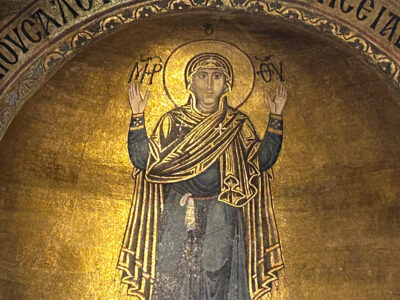
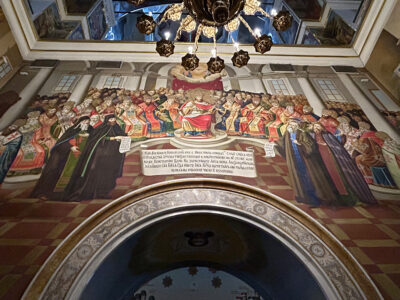
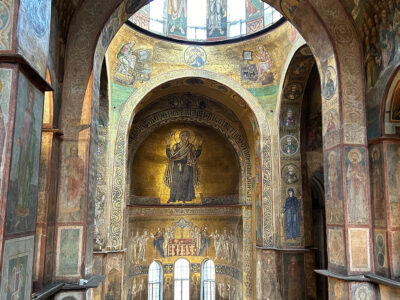
Chaplains
We have meetings with the central chaplains of the national guard and the Ukrainian armed forces. We are given a clear presentation of the process of the chaplaincy work. It is positive to see the desire to set up a national chaplaincy service which will help military personnel of different Christian denominations and religions to find support in their lives of faith. One concern they express is the need for formation of the chaplains. At the same time, it is noted that the Ukrainian chaplains have unique frontline war experiences to share with their colleagues in other countries.
The dedication of the chaplains to Jesus and his people is truly impressive. It is risky work. So far, about 30 chaplains have died in this war, and others continue to risk their lives to stay close to their military and give spiritual support. Some of them are part of the national chaplaincy service, others are volunteers supported by their churches. A young chaplain takes me aside and quietly presses a plastic rosary into the palm of my hand. He looks me in the eyes and asks me to pray for him and his people. Another chaplain hands me the first copy of his booklet with poetic and artistic expressions in war time, which will be presented later. He too intensely asks for my prayers.
Space for culture
We are told that waves of drones attacked the city overnight. Thankfully no one was hurt as the drones were destroyed in time. It is a surreal experience to enter the national opera theatre immediately after hearing this news. In here, it seems all the worries of war have been left outside the doors. Flocks of young girls in beautiful evening dresses take selfies in a huge mirror while casually dressed middle-aged men and women walk past on their way to their seats. A hostess hands us a program and shows us the way into a huge classical oval theatre, predominantly white with gilded ornaments and a beautifully lit ceiling. As we sit down in our chairs, our eyes are drawn to the red curtain which is about to be opened for the performance.
The ballet gives evidence of an enormous amount of talent and sense of culture. We are dazed when we are back on the streets and think back to the colourful dresses and gracious movements. Now I can better understand the concern of one of the chaplains, who said that it is great when culture can offer people a chance to forget the war momentarily. However, he also warned of the danger that some people in Kyiv tend to live as if there is no war at all. For example, help is needed for victims and people should seek shelter in case of an air raid…

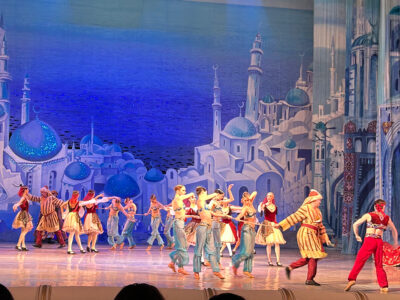
Strength
In the streets of Kyiv, I notice many a flower seller, something one would not immediately expect in a country at war. It is as if even the flower sellers want to defend the sovereignty of their borders by keeping up their simple way of bringing joy and hope through their beautiful flowers. In general, I am touched by the strength of the people in this extremely difficult situation. This is evinced in very different ways and gives reason for hope.
A man sits under a tree in front of the Sophia Cathedral and plays on a traditional string instrument. His deep, sonorous voice is intense, and it seems to express a desire for freedom and peace. God is at work here, in spite of the horrors caused by his creatures, and he is with all people who are suffering.

